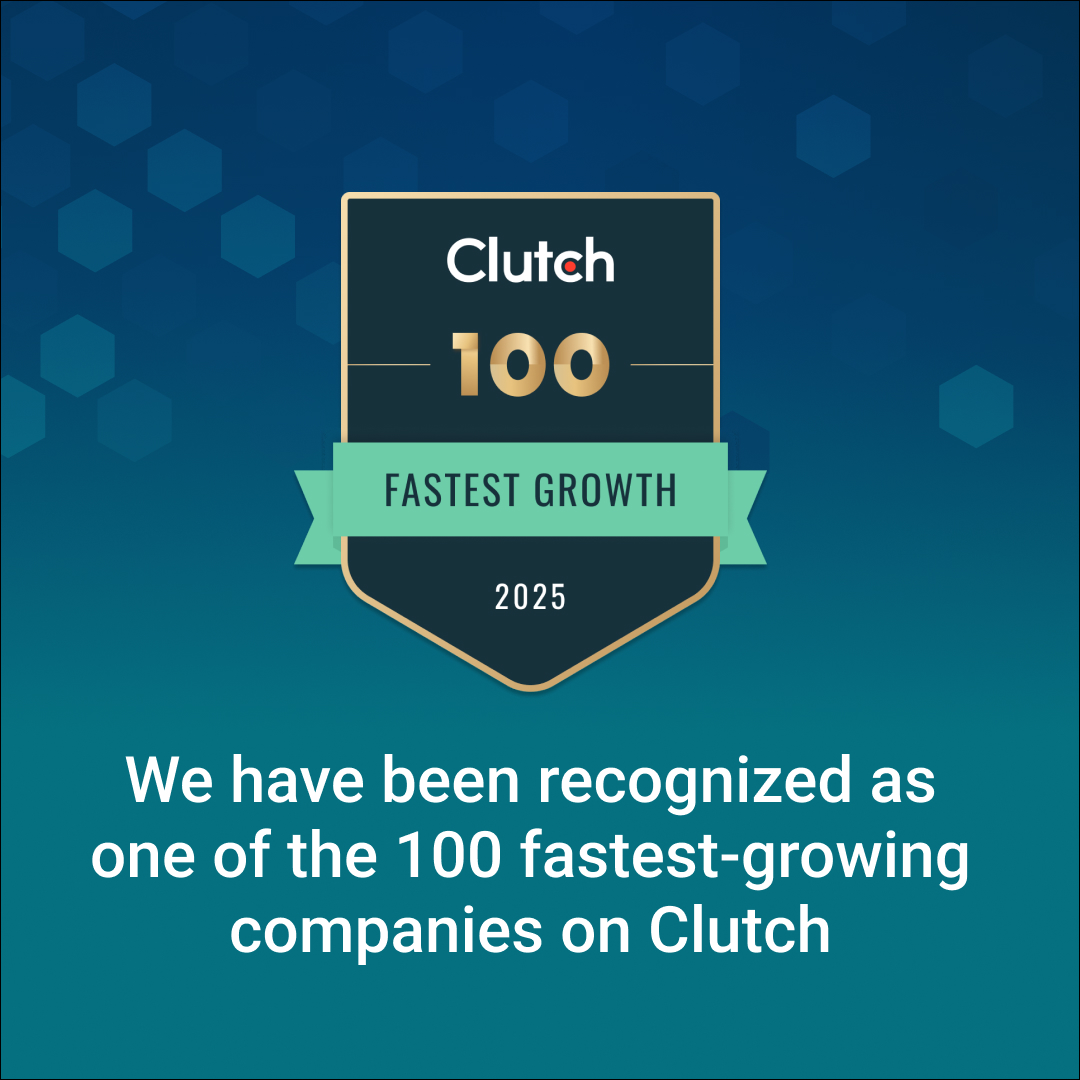Introduction
Mining operations are under pressure: ore grades are declining, safety risks mounting, environmental regulations tightening, and stakeholder expectations for sustainability rising. AI is becoming a powerful enabler—accelerating exploration, reducing waste, improving safety, and helping mines operate more efficiently and cleanly.
This in‑depth guide explores how AI is creating real‑world impact in mining from boosting discovery rates and optimizing processes to enhancing ESG outcomes, while also examining the challenges and strategic considerations for implementation.
What is AI and Why Does It Matter in Mining?
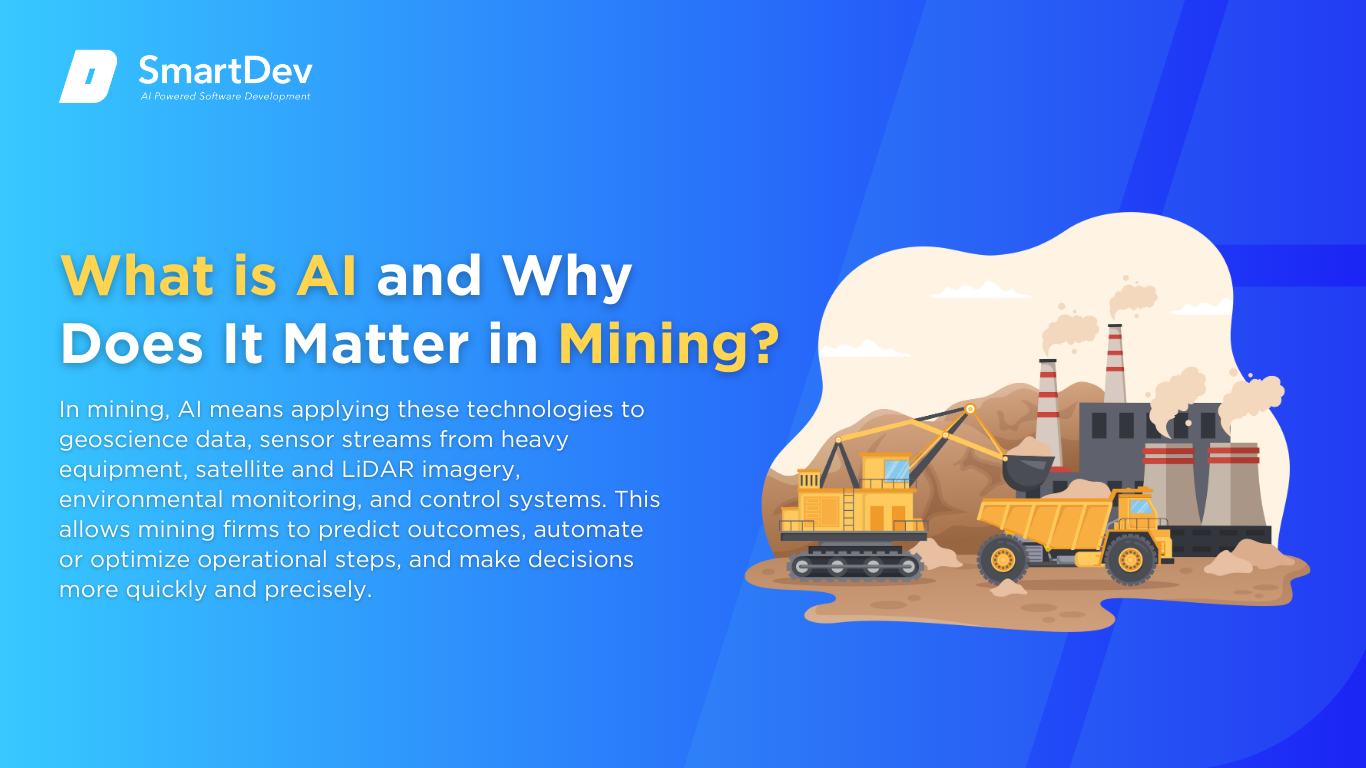
Definition of AI and Its Core Technologies
AI refers to systems capable of performing tasks that would normally require human intelligence, including learning from data, recognizing patterns, making decisions under uncertainty, and adapting over time. Core technologies include machine learning (ML), deep learning, computer vision, sensor fusion, and predictive analytics.
In mining, AI means applying these technologies to geoscience data, sensor streams from heavy equipment, satellite and LiDAR imagery, environmental monitoring, and control systems. This allows mining firms to predict outcomes (like ore quality, equipment failure, or environmental risk), automate or optimize operational steps, and make decisions more quickly and precisely.
The Growing Role of AI in Transforming Mining
AI is transforming mining from a manual, high-risk, resource-intensive sector into a digitally optimized, data-driven industry. Traditional approaches based on trial-and-error and static processes are being replaced by intelligent systems that can continuously adapt to real-time conditions. From exploration to extraction and processing, AI allows mining companies to make faster, more accurate decisions, reduce variability, and optimize performance.
Moreover, AI enhances operational visibility across the value chain. Machine learning models detect ore quality trends, forecast equipment failures, and dynamically adjust process parameters to maximize throughput. This intelligence enables proactive maintenance, energy savings, and safer working conditions. In parallel, AI supports sustainability efforts by tracking emissions, optimizing water use, and improving waste management, aligning mining practices with growing ESG demands.
Key Statistics and Trends in AI Adoption in Mining
AI adoption in mining is accelerating as companies seek smarter, safer, and more sustainable operations. According to Grand View Research, the global AI in mining market was valued at $29.94 billion in 2024 and is projected to reach $685.61 billion by 2033, growing at an exceptional CAGR of 41.9%. The demand is driven by rising pressure to reduce costs and environmental impact while improving output and safety.
The adoption landscape is also evolving by segment. Surface mining currently accounts for the largest share, with over 56% of AI deployments focused on open-pit operations. Key applications include predictive maintenance, fleet automation, and geological modeling. Meanwhile, deep learning and machine learning represent nearly 40% of AI technologies used in the industry, underscoring the shift toward intelligent process optimization and automation.
With growing investment in digital infrastructure, particularly in Asia-Pacific and Latin America, AI is poised to become a core pillar of mining transformation. Hybrid cloud solutions, edge AI, and sensor-driven platforms are making it easier for companies to integrate advanced analytics even in remote, high-risk locations. As technology matures, AI is no longer an experimental upgrade but a strategic necessity for operational resilience and long-term competitiveness.
Business Benefits of AI in Mining
AI is solving foundational business challenges in mining, ranging from production inefficiencies and costly downtime to environmental risk and safety incidents. Below are five key areas where AI is delivering measurable, enterprise-level value:
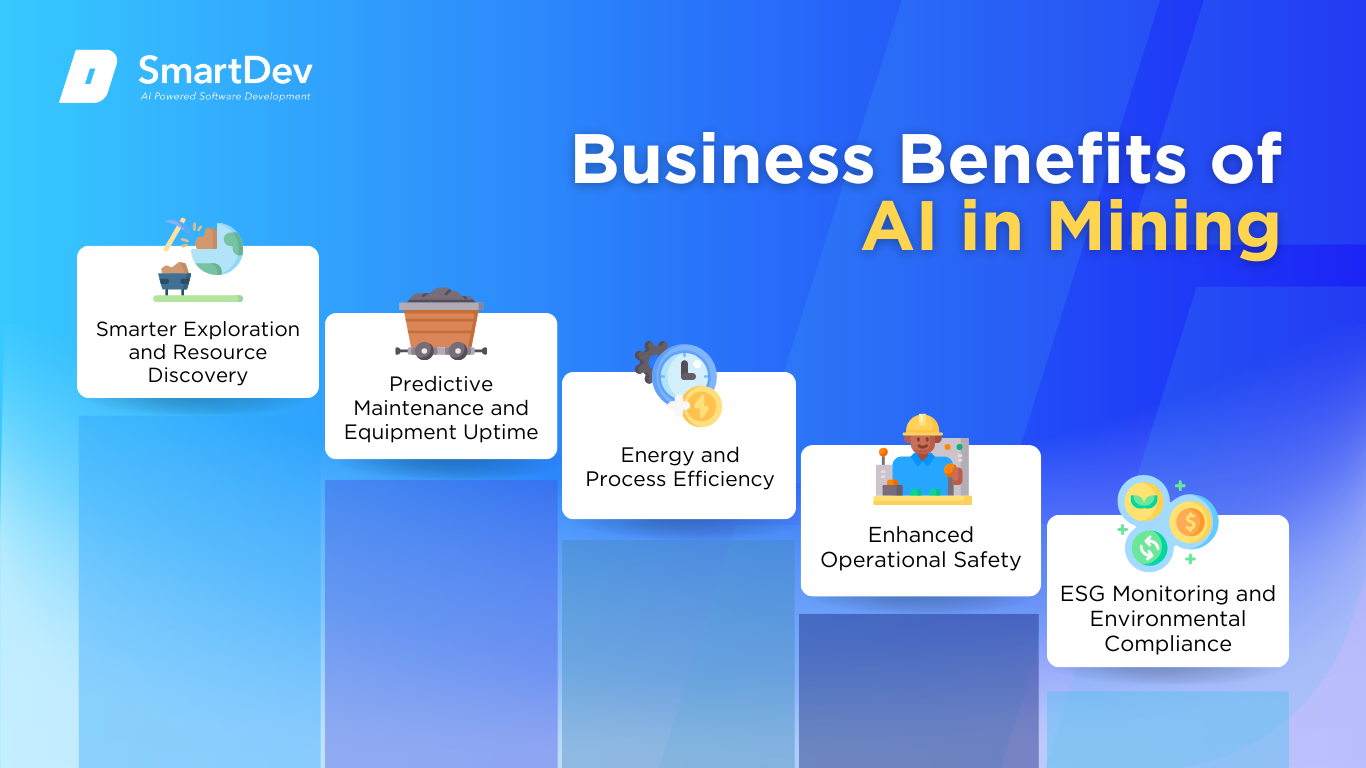
1. Smarter Exploration and Resource Discovery
AI algorithms can rapidly analyze vast geological datasets, including drill core logs, geophysical surveys, and remote sensing imagery to pinpoint areas with high mineralization potential. Unlike manual methods that rely on linear interpretation, machine learning models detect nonlinear relationships and subtle geological indicators of ore bodies. These insights help geologists prioritize zones for field validation, reducing reliance on trial-and-error exploration.
This precision significantly reduces exploration timelines and lowers costs associated with drilling in low-probability zones. With targeted drilling and fewer field campaigns, mining companies can allocate capital more efficiently while minimizing land disturbance and environmental impact. In an era of declining ore grades and rising discovery costs, AI becomes a competitive differentiator in front-end resource planning.
2. Predictive Maintenance and Equipment Uptime
AI-powered predictive maintenance uses real-time sensor data, such as vibration, temperature, and pressure readings to detect early signs of equipment degradation. These models learn baseline equipment behavior and identify anomalies that often precede mechanical failure. This proactive approach allows maintenance teams to intervene before breakdowns occur, avoiding costly downtime.
The benefits extend beyond just reliability. Predictive insights enable better planning of maintenance schedules, reduce spare parts overstocking, and extend asset lifespan. For high-value machinery like crushers, haul trucks, and conveyors, this translates into millions in savings and improved production continuity.
3. Energy and Process Efficiency
AI systems continuously monitor and optimize process parameters in response to changing ore conditions, such as variations in hardness, moisture, or feed size. These adjustments like modifying mill speed or adjusting reagent dosage help maintain stable throughput and maximize recovery rates. The result is a more adaptive process that reduces energy intensity and reagent waste.
Over time, these gains compound across the operation. Reducing kilowatt-hours per ton processed or chemical use per ton of concentrate not only cuts costs but also reduces greenhouse gas emissions. This operational agility supports both profitability and environmental performance targets.
4. Enhanced Operational Safety
AI-enabled safety systems integrate data from cameras, wearables, environmental sensors, and vehicle telemetry to detect potential hazards in real time. For example, computer vision can spot unsafe worker behavior, proximity alerts can prevent vehicle collisions, and gas sensors can identify buildup before it becomes critical. These insights trigger automated alerts or even shutdown protocols to prevent accidents.
Safety automation reduces human exposure to dangerous tasks or zones, particularly when combined with remote or autonomous equipment. This not only lowers incident rates but also improves compliance with health and safety regulations. By embedding safety intelligence into operations, mines build more resilient and responsible workplaces.
5. ESG Monitoring and Environmental Compliance
AI platforms can consolidate and analyze environmental data from diverse sources—such as satellite imagery, tailings dam sensors, water discharge monitors, and emissions trackers. These systems flag deviations in real time, helping companies take corrective action before breaches occur. The transparency enabled by AI-driven dashboards supports both internal accountability and external reporting.
With growing scrutiny from regulators, investors, and communities, proactive ESG performance is now a business imperative. AI helps mining companies demonstrate compliance, reduce risk of fines or license delays, and align with global sustainability frameworks. By integrating AI into ESG strategies, companies build credibility and long-term stakeholder trust.
Challenges Facing AI Adoption in Mining
Despite its growing impact, AI adoption in gaming comes with significant business challenges that can slow implementation or limit ROI. Below are five of the most pressing obstacles studios and publishers face when integrating AI into game development and operations:
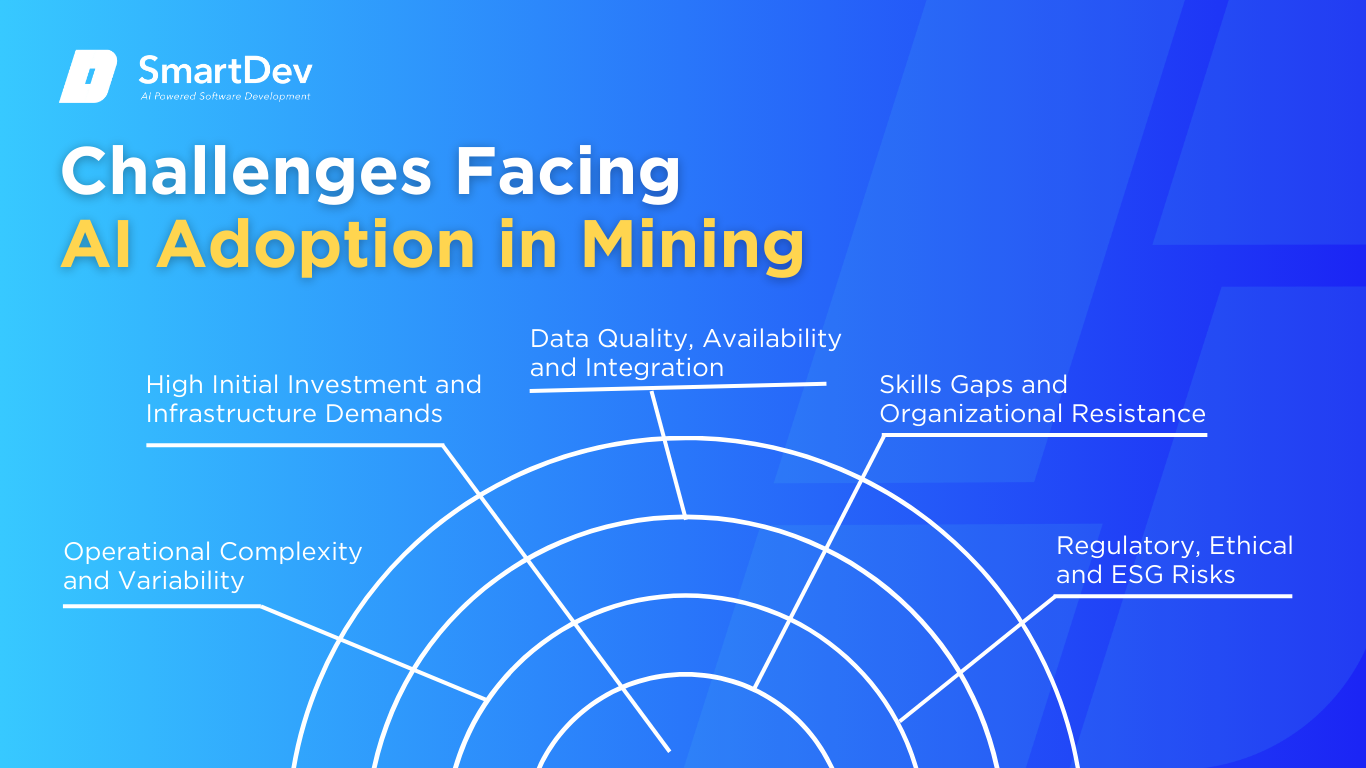
1. Data Quality, Availability and Integration
AI systems rely on high-quality, structured, and continuous data streams, but many mining operations still depend on fragmented, outdated, or manually recorded data sources. Geological data may be stored in legacy formats, equipment sensors may be missing or inconsistent, and operational data often exists in silos across departments. This lack of clean, centralized data severely limits the effectiveness and accuracy of AI models.
Integrating data across exploration, operations, maintenance, and ESG systems requires robust IT infrastructure and significant data engineering work. Without standardized protocols and real-time connectivity, AI tools can produce misleading or incomplete insights. As a result, many promising AI pilots stall at the scaling phase due to unresolved data foundation issues.
2. High Initial Investment and Infrastructure Demands
Deploying AI solutions in mining requires significant upfront investment in sensors, edge devices, network connectivity, data storage, and computing power. In remote or underground operations, the cost of establishing reliable connectivity and powering advanced systems can be prohibitively high. These capital requirements can deter smaller companies or projects with tight margins.
In addition to hardware, software licensing, integration services, and training contribute to the total cost of ownership. Without a clear and timely return on investment, stakeholders may hesitate to allocate budget for AI initiatives. This financial barrier slows widespread adoption, especially outside of large or technologically advanced mining firms.
3. Operational Complexity and Variability
Mining environments are highly dynamic—ore properties, weather conditions, equipment usage, and material flow can shift unpredictably. AI models trained on historical data may struggle to remain accurate under such variable conditions unless they are constantly updated. This makes it challenging to develop robust, scalable solutions that perform reliably across different sites and scenarios.
Moreover, legacy equipment and control systems often lack the digital interfaces needed to support real-time AI integration. Retrofitting these systems introduces added cost, complexity, and downtime risk. The technical difficulty of operating AI in such conditions remains one of the most underappreciated hurdles in the industry.
4. Skills Gaps and Organizational Resistance
Mining companies often lack in-house expertise in data science, machine learning, and AI systems integration. Existing teams may be unfamiliar with the requirements of digital workflows or may distrust algorithm-driven decision-making. This creates resistance at both operational and management levels, particularly if the business case for AI is not clearly communicated.
In addition, adopting AI often requires rethinking job roles, training programs, and internal processes. Without strong change management, digital transformation initiatives risk stalling due to lack of buy-in or capacity. Building a workforce that can collaborate effectively with AI systems is just as critical as the technology itself.
5. Regulatory, Ethical and ESG Risks
AI systems in mining must operate within a complex web of regulatory, environmental, and social frameworks. Misuse or malfunction of AI, such as an autonomous system making a safety-critical error, raises questions of accountability and liability. Additionally, data collection methods (e.g., monitoring workers or communities) can lead to privacy or ethical concerns.
From an ESG perspective, if AI-driven decisions inadvertently increase environmental harm or exclude community input, companies face reputational and compliance risks. Regulators are increasingly scrutinizing how technology is applied in sensitive industries like mining. Transparent governance, clear policies, and ethical AI practices are essential to avoid backlash and build trust.
Specific Applications of AI in Mining
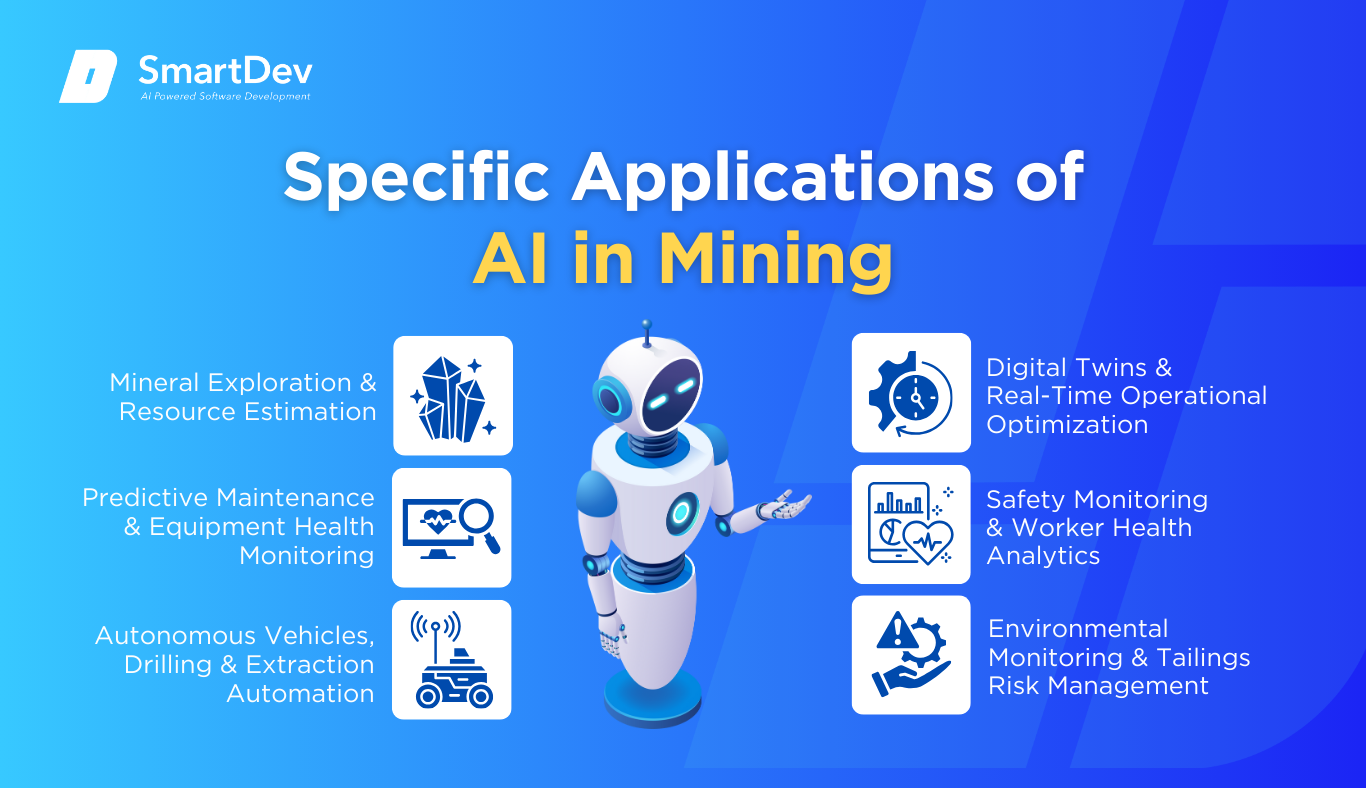
1. Mineral Exploration & Resource Estimation
AI-driven mineral exploration uses machine learning models to predict the location of high-potential mineral deposits, solving the high cost and low success rate of traditional exploration methods. These models process geospatial datasets, geophysical surveys, satellite imagery, and historical drilling logs to detect patterns associated with known mineralization. When integrated with geological mapping tools and field operations, they provide precise drilling targets, reducing time and cost in exploration campaigns.
This application enhances resource estimation accuracy, optimizes exploration budgets, and accelerates time-to-discovery. Strategically, it reduces environmental disruption by minimizing unnecessary drilling and helps companies focus capital on the most promising zones. However, it depends on comprehensive, high-resolution datasets and often requires collaboration between data scientists and geologists.
Technical challenges include ensuring spatial data quality, model generalization across geological contexts, and continuous model refinement as new drilling data becomes available. There are also ethical considerations around the environmental impact of AI-driven decisions and the need for transparent model reasoning in high-stakes exploration investment.
Real-World Example: KoBold Metals uses AI models trained on public and proprietary geoscience datasets to locate new sources of critical minerals like copper and cobalt. Their system prioritizes exploration targets using satellite imagery and machine learning pipelines. This has helped reduce false positives and focus exploration efforts, leading to faster and more cost-effective discoveries.
2. Predictive Maintenance & Equipment Health Monitoring
Predictive maintenance uses AI to anticipate equipment failures before they occur, solving the problem of unplanned downtime and costly repairs in heavy mining operations. Sensors on critical machinery (e.g., haul trucks, crushers, mills) collect real-time data such as vibration, temperature, and acoustic signals. These inputs feed into ML models trained on historical failure patterns to detect early warning signs and trigger alerts.
This proactive approach extends equipment life, minimizes operational disruptions, and improves worker safety. It also allows for optimized maintenance scheduling, reduced spare part inventory, and better CAPEX planning. The strategic value lies in maximizing asset utilization and maintaining continuous production flow in harsh environments.
Key considerations include sensor calibration, data integrity, and integration with maintenance management systems. Models must be retrained periodically to adapt to equipment wear, operating conditions, and varying usage patterns across sites.
Real-World Example: Freeport-McMoRan leveraged AI and robotics platforms like Gecko Robotics to monitor equipment health and predict mechanical failures. Their system processes high-frequency sensor data to identify degradation trends and schedule maintenance accordingly. The result was improved safety, fewer unexpected stoppages, and a measurable increase in equipment uptime.
3. Autonomous Vehicles, Drilling & Extraction Automation
AI enables the automation of haulage trucks, drills, and loaders, addressing labor shortages, safety risks, and inefficiencies in extraction operations. Autonomous systems use LiDAR, radar, GPS, and onboard AI to navigate, avoid obstacles, and execute tasks without human intervention. These systems are integrated into centralized control centers that oversee fleet coordination and operational logistics.
Automation delivers 24/7 operations, improves precision, and removes human workers from hazardous zones. The productivity gains include lower labor costs, reduced fuel consumption, and fewer accidents caused by human error. Strategically, it supports mining in remote or high-risk environments while improving operational predictability.
Technical challenges include terrain variability, real-time system latency, and safe handover between autonomous and human-controlled systems. Regulatory approvals and social acceptance of workforce displacement are also critical considerations.
Real-World Example: Rio Tinto operates one of the world’s largest autonomous truck fleets in the Pilbara region of Australia. Their AI-powered system autonomously manages haul routes, dump locations, and pit loading. It has resulted in a 15% boost in productivity and a significant reduction in operating costs.
4. Digital Twins & Real-Time Operational Optimization
Digital twins replicate physical mine operations virtually, solving the challenge of real-time performance monitoring and scenario testing. These AI-enabled models simulate processes across the mining value chain like extraction, transport, processing, by continuously syncing with sensor data. Operators can run “what-if” simulations, identify bottlenecks, and optimize throughput without disrupting live operations.
This application improves decision-making, enables agile responses to changes in ore quality or equipment behavior, and supports energy and cost optimization. It also reduces trial-and-error experimentation in the field, leading to more efficient and safer operations. Strategically, it unifies cross-departmental planning with a data-driven approach.
Developing effective digital twins requires high-fidelity data, system integration, and advanced visualization platforms. Maintenance of real-time accuracy and security in cloud-connected environments are essential for operational trust and value.
Real-World Example: BHP implemented digital twin technology to simulate operations from mine site to port in their Escondida project. These twins allowed engineers to forecast production impacts, test process changes, and streamline logistics. The initiative led to better decision-making, improved output forecasting, and reduced environmental impact.
5. Safety Monitoring & Worker Health Analytics
AI-powered safety systems use sensor data and computer vision to detect hazardous conditions, solving the persistent risk of injury and fatalities in mining environments. Wearables track biometrics like fatigue, heat stress, and vital signs, while cameras monitor PPE compliance and unsafe behavior. AI models analyze this data in real time to issue alerts, log incidents, and trigger interventions.
These systems create a safer workplace, enable early response to health risks, and improve regulatory compliance. Predictive analytics reduce accident rates and enable smarter shift planning. They also enhance transparency and morale, helping companies meet ESG and labor safety commitments.
Challenges include data privacy of employees, accuracy of AI judgment in diverse environments, and ensuring alert fatigue doesn’t reduce response rates. Successful implementation requires strong integration between safety teams, HR, and tech platforms.
Real-World Example: Barrick Gold uses wearable devices and edge computing at the Reko Diq project to monitor miner fatigue and environmental hazards. Their system analyzes biometric signals to detect risks and alert supervisors. It contributed to fewer lost-time injuries and improved compliance with occupational safety standards.
6. Environmental Monitoring & Tailings Risk Management
AI solutions for environmental monitoring address the need for real-time oversight of emissions, water quality, and tailings dam stability. Sensors, satellites, and drones collect data on gas levels, toxic runoff, water usage, and structural integrity. AI models analyze this data to detect anomalies, forecast failures, and recommend remediation actions.
This reduces regulatory violations, improves community trust, and helps achieve sustainability targets. Early warning systems for dam breaches or contamination events protect human life and avoid catastrophic financial losses. Strategically, it strengthens ESG positioning and operational resilience.
Barriers include sparse monitoring in remote areas, integration with legacy systems, and the complexity of geological variables. There is also a need for regulatory alignment and third-party validation of AI recommendations in high-risk zones.
Real-World Example: Natural Resources Canada developed AI tools to combine subsurface data and satellite imagery for monitoring water pollution and dam stability. Their system predicts potential seepage and flags environmental risks proactively. This has improved compliance and reduced remediation costs for participating mining firms.
Need Expert Help Turning Ideas Into Scalable Products?
Partner with SmartDev to accelerate your software development journey — from MVPs to enterprise systems.
Book a free consultation with our tech experts today.
Let’s Build TogetherExamples of AI in Mining
Real-World Case Studies
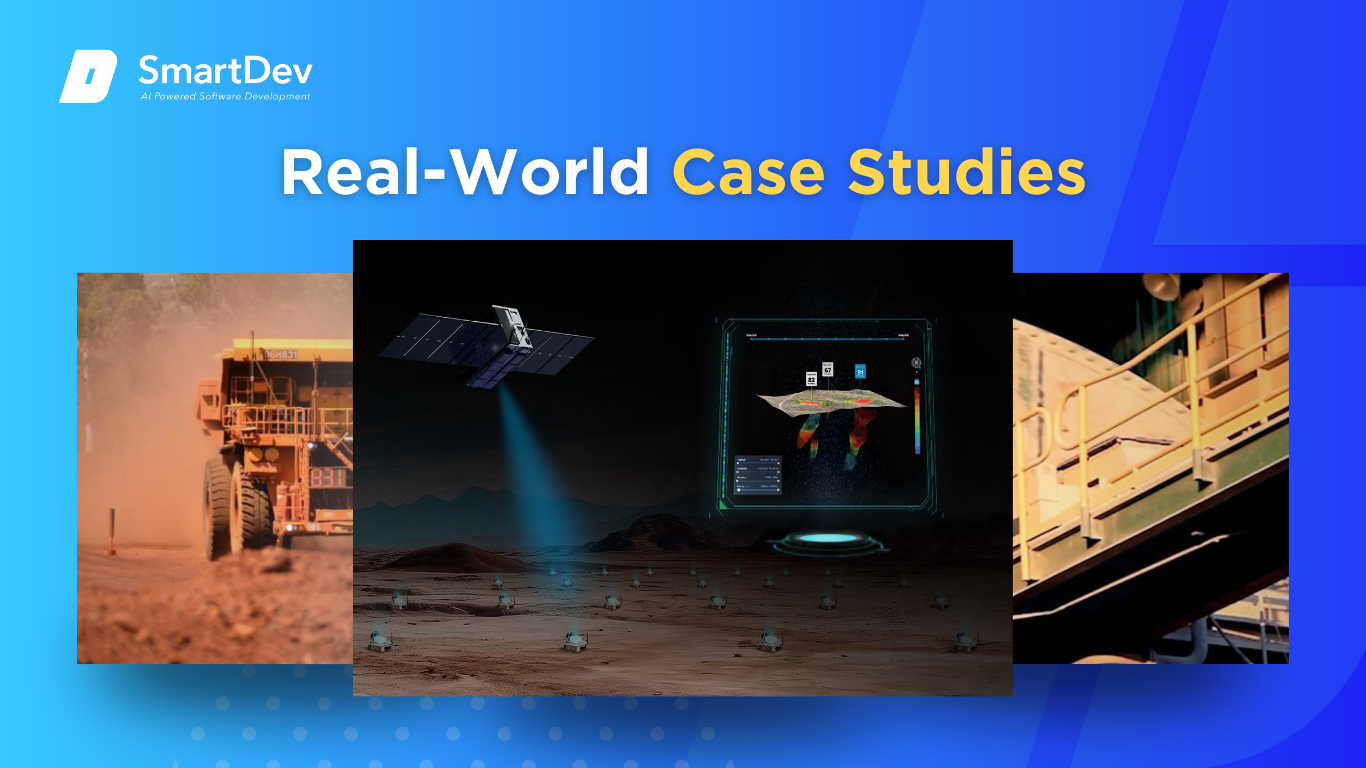
1. Freeport‑McMoRan: AI-Driven Productivity Gains in Copper Mining
To address declining ore grades and improve operational efficiency, Freeport‑McMoRan adopted an AI-centric transformation initiative across its North and South American copper mines. The company aimed to boost throughput without significant capital expansion by leveraging real-time operational data and predictive analytics. AI tools were deployed to optimize processing, anticipate equipment failure, and uncover hidden efficiencies across the mining value chain.
The initiative used machine learning models trained on decades of sensor data from concentrators, crushers, and haul fleets. Data from thousands of variables were processed by AI systems that could identify performance drift, equipment wear, or energy inefficiencies. These insights were fed into control systems, allowing automatic adjustments and human-in-the-loop decision making to fine-tune operations.
As a result, Freeport increased annual copper production by 90,000 tons with no new processing facilities, while reducing costs by approximately 10%. The use of AI significantly decreased unplanned downtime and improved overall throughput. This case demonstrates the power of AI in unlocking latent capacity and enhancing asset performance in large-scale mining operations.
2. BHP: Using Digital Twins to Optimize Value Chain Operations
BHP implemented digital twin technology across its mining portfolio to create real-time virtual replicas of its end-to-end operations, including extraction, processing, rail transport, and port logistics. The goal was to simulate and optimize processes before physical implementation, reduce waste, and make more informed strategic decisions. This initiative also aimed to support sustainability by predicting the environmental impact of operational changes.
The digital twins ingested data from IoT sensors, fleet tracking systems, and ERP software to build interactive models of entire workflows. AI algorithms modeled different “what-if” scenarios around ore blending, equipment scheduling, and route planning, providing predictive insights into downstream effects. Engineers used these simulations to avoid bottlenecks, improve throughput, and minimize fuel consumption.
With the system in place, BHP reported faster scenario planning, improved production forecasts, and up to a 15% gain in logistics efficiency. The ability to simulate interventions before deployment reduced trial-and-error risk and improved collaboration across departments. This example highlights how AI-enabled digital twins are transforming operational planning in mining.
3. Barrick Gold & Fleet Space: Accelerated Exploration in Reko Diq
Facing the challenge of mapping subsurface copper deposits in the rugged Reko Diq region of Pakistan, Barrick Gold partnered with Fleet Space Technologies to deploy an AI-powered exploration platform. The aim was to dramatically speed up geological discovery while reducing environmental impact from unnecessary drilling. Their strategy relied on remote sensing, seismic data, and edge computing to create real-time 3D subsurface maps.
The system, called ExoSphere, used geophysical sensors that gathered and transmitted underground data to cloud platforms. AI models processed this data to identify probable mineralization zones, allowing field teams to target drilling efforts with higher precision. Compared to conventional approaches, the AI platform cut exploratory timelines from months to days and significantly reduced land disruption.
Barrick reported over 90% time savings in initial surveying phases and minimized exploratory drilling by more than 50%. The reduced environmental footprint and faster discovery timelines demonstrated how AI can make mineral exploration smarter, faster, and greener. This case sets a benchmark for sustainable exploration through AI innovation.
Innovative AI Solutions
AI-Driven Innovations Transforming Mining
Emerging Technologies in AI for Mining
Generative AI is transforming how mining companies approach exploration and production planning. These models rapidly analyze vast geological datasets to predict where valuable mineral deposits are likely to be found, accelerating discovery and reducing reliance on manual interpretation. In production, generative systems can simulate entire mining scenarios, offering dynamic recommendations that improve efficiency and reduce trial-and-error in critical decision-making.
Computer vision is playing a pivotal role in enhancing visibility and control across the mining value chain. From identifying ore grades on conveyor belts to monitoring equipment performance and environmental conditions, AI-powered visual systems provide continuous oversight. These models detect anomalies in real time, automate sorting processes, and contribute to higher safety standards by identifying hazards that would otherwise be missed by the human eye.
Agentic AI is emerging as a game-changer for operational autonomy. These self-directed systems manage real-time decision-making across interconnected workflows, like coordinating fleets of vehicles, optimizing material transport, or adjusting blast schedules. As these models learn from live data and adapt over time, they bring agility to mining operations, ensuring better resource utilization, minimized downtime, and more responsive production cycles.
AI’s Role in Sustainability Efforts
AI is increasingly integral to mining’s push toward sustainability by enabling smarter, cleaner operations. Predictive models anticipate where inefficiencies are likely to occur in the production process, such as energy loss, waste generation, or equipment wear and intervene with optimized alternatives. This reduces excess material movement, limits resource waste, and improves the life span of both equipment and ore bodies.
Energy optimization is another critical area where AI delivers tangible environmental benefits. Intelligent systems dynamically adjust power usage across facilities, aligning energy consumption with actual operational demand. From regulating ventilation and water usage to managing power-intensive equipment during non-peak hours, AI reduces the environmental load while maintaining productivity.
How to Implement AI in Mining
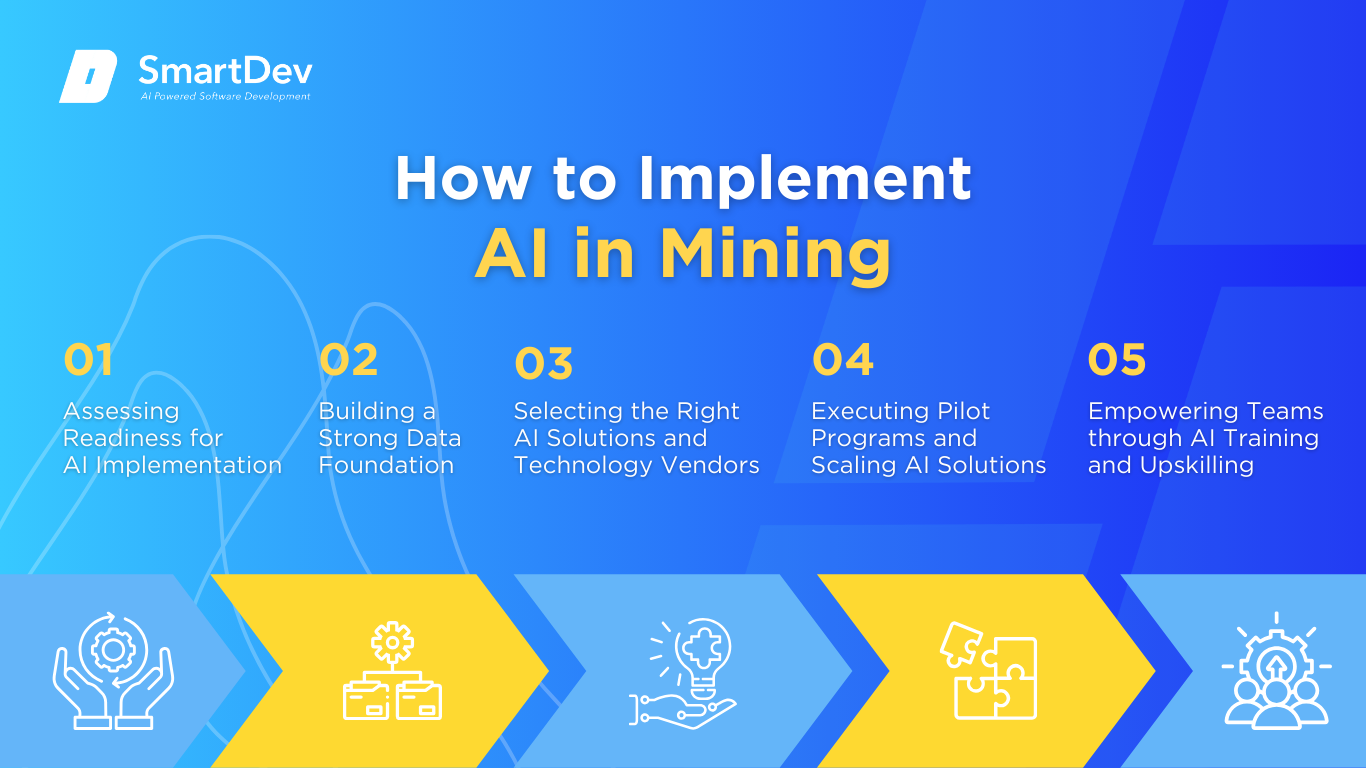
Step 1: Assessing Readiness for AI Adoption
Before introducing AI into mining operations, it’s essential to evaluate where it can generate the most measurable value. Start by identifying operational areas that are repetitive, heavily data-driven, or prone to inefficiencies. These often include equipment maintenance, ore processing, safety monitoring, and logistics coordination, functions where automation and predictive capabilities can significantly improve throughput and consistency.
Readiness also involves aligning infrastructure, strategy, and organizational mindset. Conducting a comprehensive audit helps determine the availability of usable data, the compatibility of current systems with AI tools, and the digital literacy across teams. Engaging stakeholders from engineering, operations, and IT early in the process ensures better alignment, minimizes resistance, and sets a foundation for achievable, ROI-driven goals.
Step 2: Building a Strong Data Foundation
AI systems are only as good as the data that powers them. For mining operations, building a reliable data foundation starts with consolidating inputs from equipment sensors, geological databases, environmental monitoring systems, and operational logs. Clean, structured, and time-stamped data is critical for training accurate models that reflect real-world conditions.
Effective data management also includes setting up robust pipelines that can collect, process, and store data efficiently. Whether it’s real-time readings from underground sensors or historical maintenance records, consistency and accessibility matter. Establishing data governance protocols, ensures that your AI initiatives don’t stall due to gaps in reliability or trust.
Step 3: Choosing the Right Tools and Vendors
Selecting the right AI tools requires a balance between capability, customization, and integration. Mining companies should focus on platforms that support their specific use cases, while ensuring these solutions can scale with future needs. Cloud compatibility, real-time analytics, and automation support are essential features to look for.
Choosing vendors also involves evaluating long-term support, adaptability to rugged environments, and how well the tool fits within the existing technology stack. Some operations may benefit from pre-built AI modules, while others require tailored models developed in close collaboration with external partners. Clarity on budget, training needs, and deployment timelines helps filter out solutions that overpromise or underdeliver.
Step 4: Pilot Testing and Scaling Up
Starting small is key to a successful AI rollout in mining. Focus on one or two high-impact use cases where results can be measured clearly, like optimizing fuel usage in haul trucks or automating crushing plant operations. These pilots offer a controlled environment to validate assumptions, fine-tune data pipelines, and measure performance without disrupting core operations.
Once pilot success is established, scaling becomes a matter of replication and adaptation. Lessons learned from the initial rollout inform larger implementations, helping to avoid inefficiencies and better align the technology with real-world constraints. Regular iteration, feedback loops, and cross-department collaboration ensure the AI systems remain adaptable as the operation evolves.
Step 5: Training Teams for Successful Implementation
People are the linchpin in AI transformation. Upskilling existing teams to work alongside AI not only improves adoption but also reduces resistance to change. Training programs should focus on both technical skills, such as interpreting AI outputs or managing digital interfaces and operational context, helping staff understand how AI decisions impact safety, quality, and performance.
Cross-functional collaboration should also be encouraged, as AI applications often span departments. Bridging gaps between field operators, engineers, data teams, and leadership fosters a shared understanding and smoother integration. Ongoing support, role-specific learning paths, and peer mentoring can all reinforce a culture of digital innovation from the ground up.
Measuring the ROI of AI in Mining
Key Metrics to Track Success
Measuring the return on AI in mining is about linking efficiency, safety, and cost savings back to real financial outcomes. One of the clearest indicators of ROI is increased production efficiency. Mining teams often evaluate how many more tons of ore are processed, how quickly maintenance issues are resolved, or how much less downtime is experienced compared to traditional processes. These metrics help quantify gains in productivity and overall throughput.
Cost reduction is another high-impact area. AI minimizes unplanned equipment failures, cuts energy usage in processing plants, and reduces reliance on manual monitoring and interventions. These changes lower operating expenses without compromising safety or performance. Improvements in predictive maintenance, real-time decision-making, and smarter resource allocation translate into fewer stoppages, optimized energy use, and reduced material waste, each contributing to the bottom line.
Case Studies Demonstrating ROI
Practical implementations of AI in mining consistently showcase meaningful returns. When AI-driven maintenance systems are used to detect early signs of equipment wear, operators can intervene before costly failures occur. This shift from reactive to predictive maintenance significantly reduces repair costs and eliminates downtime, often paying for itself within months of deployment.
In processing facilities, AI-based optimization systems adjust parameters like grinding time, chemical dosage, and throughput rates in real time. These models help maintain consistent quality while minimizing energy and reagent use. Over time, this leads to measurable reductions in unit operating costs and improves recovery rates, enhancing both environmental and financial performance.
AI has also made a difference in mine planning and scheduling. Algorithms that dynamically reconfigure haul routes or adjust blast timing based on daily conditions increase operational flexibility. These systems allow teams to meet production targets more reliably and with fewer delays, which positively impacts overall project economics and delivery timelines.
Common Pitfalls and How to Avoid Them
Despite the clear benefits, AI projects in mining can falter when execution is misaligned with business goals. One common pitfall is initiating AI initiatives without a clearly defined objective or measurable success criteria. Without a focused use case, it’s easy for projects to drift or fail to deliver meaningful value. The best approach is to tie AI efforts directly to existing bottlenecks or KPIs.
Another issue arises from weak data foundations. Incomplete, inconsistent, or siloed datasets can lead to inaccurate models and loss of confidence in AI outputs. Building data readiness, through quality control, integration, and standardized formats, is essential before scaling any AI solution.
Future Trends of AI in Mining
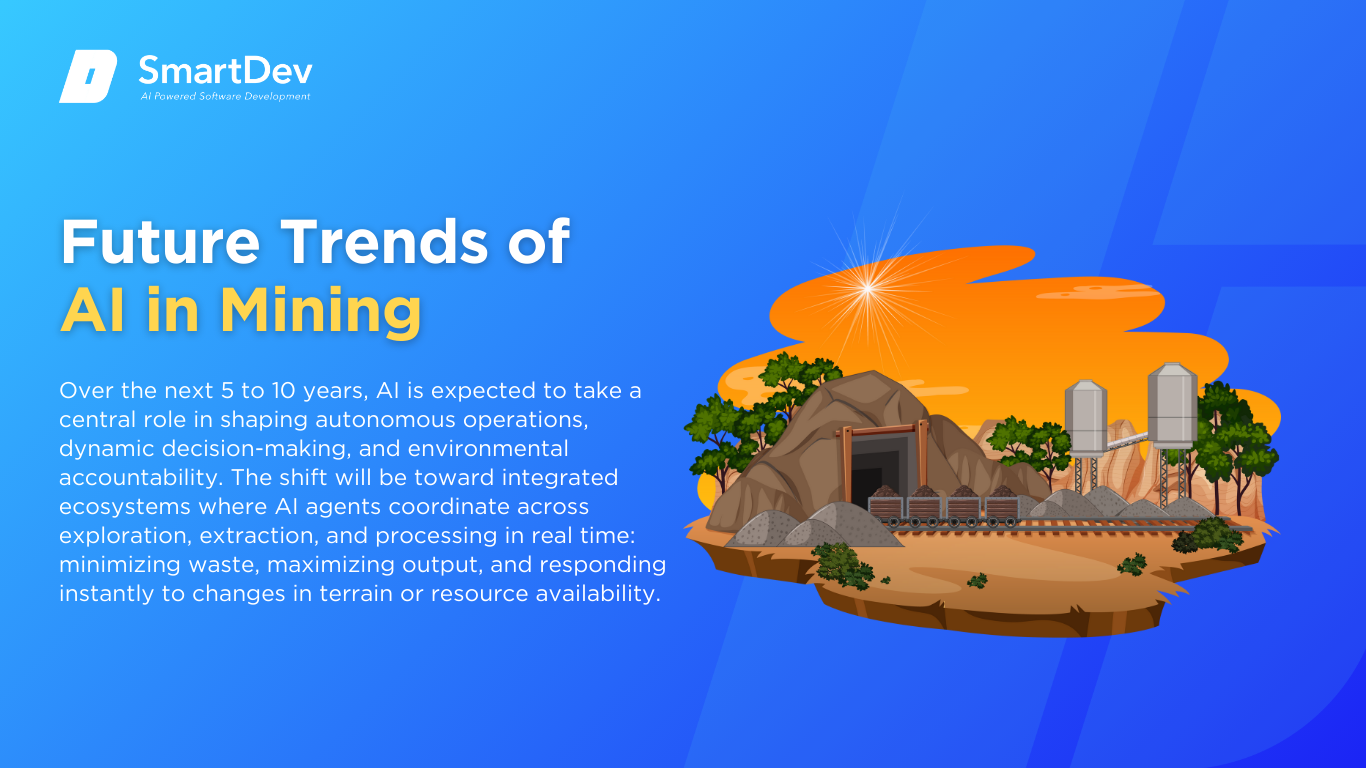
Predictions for the Next Decade
As AI continues to evolve, the mining industry is set to undergo a transformation that goes beyond automation into truly adaptive and self-optimizing systems. Over the next 5 to 10 years, AI is expected to take a central role in shaping autonomous operations, dynamic decision-making, and environmental accountability. The shift will be toward integrated ecosystems where AI agents coordinate across exploration, extraction, and processing in real time: minimizing waste, maximizing output, and responding instantly to changes in terrain or resource availability.
This next wave of innovation will likely converge with technologies like edge computing, digital twins, and satellite-based monitoring. Together, these systems will power real-time environmental tracking, autonomous equipment coordination, and predictive resource modeling with minimal human intervention. AI models will become increasingly adaptive, learning continuously from operational data and automatically refining strategies for yield optimization, safety enforcement, and emissions control. The future of mining is intelligent, resilient, and deeply interconnected.
How Businesses Can Stay Ahead of the Curve
To remain competitive, mining companies must move beyond experimenting with AI and start embedding it into their strategic planning. This requires executive leadership to prioritize digital transformation as an operational reinvention. Cross-functional teams should be empowered to prototype, test, and scale AI use cases quickly, supported by agile frameworks and iterative learning.
Success also depends on building future-proof infrastructure. That means investing in scalable data pipelines, modular AI platforms, and interoperable systems that allow for real-time feedback and rapid reconfiguration. Ethical AI governance, particularly around safety, labor dynamics, and environmental compliance, will be essential as autonomous systems become more common.
Companies that treat AI as a foundational capability will lead the next generation of intelligent mining operations. The ability to learn, adapt, and innovate continuously will define industry leaders in a landscape where precision, sustainability, and speed are non-negotiable.
Conclusion
Key Takeaways
AI is redefining the mining industry by improving efficiency, safety, and sustainability, all while delivering measurable returns on investment. From predictive maintenance and automated logistics to energy optimization and intelligent planning, AI is quickly becoming a core enabler of high-performance mining operations.
Companies that build robust data foundations, align cross-functional teams, and implement AI with clear business objectives are already realizing the benefits. As AI systems evolve toward greater autonomy and intelligence, their role will shift from operational support to strategic driver, enabling smarter, faster, and more responsible resource extraction at scale.
The industry stands at a crossroads. The decisions mining leaders make today about AI infrastructure, skills, and strategy will shape their ability to compete and thrive in the next era of digital mining.
Moving Forward: A Strategic Approach to AI in Mining
If your mining operation is ready to make AI part of its competitive advantage, now is the time to act strategically. Begin by targeting high-impact processes where AI can deliver quick wins, such as predictive maintenance, process control, or environmental monitoring. Audit your current systems and data readiness to ensure a solid foundation for long-term AI growth.
Collaborating with domain-savvy AI partners like SmartDev can accelerate implementation while minimizing disruption. These partnerships help align AI investments with operational priorities, improve deployment speed, and reduce risk. Whether your goal is to optimize production, reduce downtime, or meet rising ESG standards, a well-crafted AI roadmap will guide your transformation.
Don’t wait for industry disruption to force your hand. Lead it. Start exploring how AI can power smarter mining from pit to port, and ensure your business is equipped for a future that demands more intelligence, agility, and sustainability than ever before.
—
References:
- AI in Mining Market | KBV Research
- AI in Mining Market | Market.us
- AI in Mining Market | Precedence Research
- Artificial Intelligence in Mining Market Report | Grand View Research
- Robots and AI in Mines: Gecko Robotics and Beyond | Mining Technology
- How AI is Revolutionising Mining | BBC News
- The Role of Digital Twins and AI in Enhancing Decision-Making in Mining | BHP
- BHP Unleashes the Power of Digital at World’s Largest Copper Mine | Microsoft News Australia
- Remote Sensing and Geomatics for Natural Resources | Government of Canada
- Freeport-McMoRan: Unlocking New Mining Production Through AI Transformation | McKinsey
- Fleet Space and Barrick: AI-Powered Exploration for Mining | Fleet Space
- Rock Solid AI: How Digital Tools Are Unearthing a New Era of Mining Exploration | Cleantech Group


